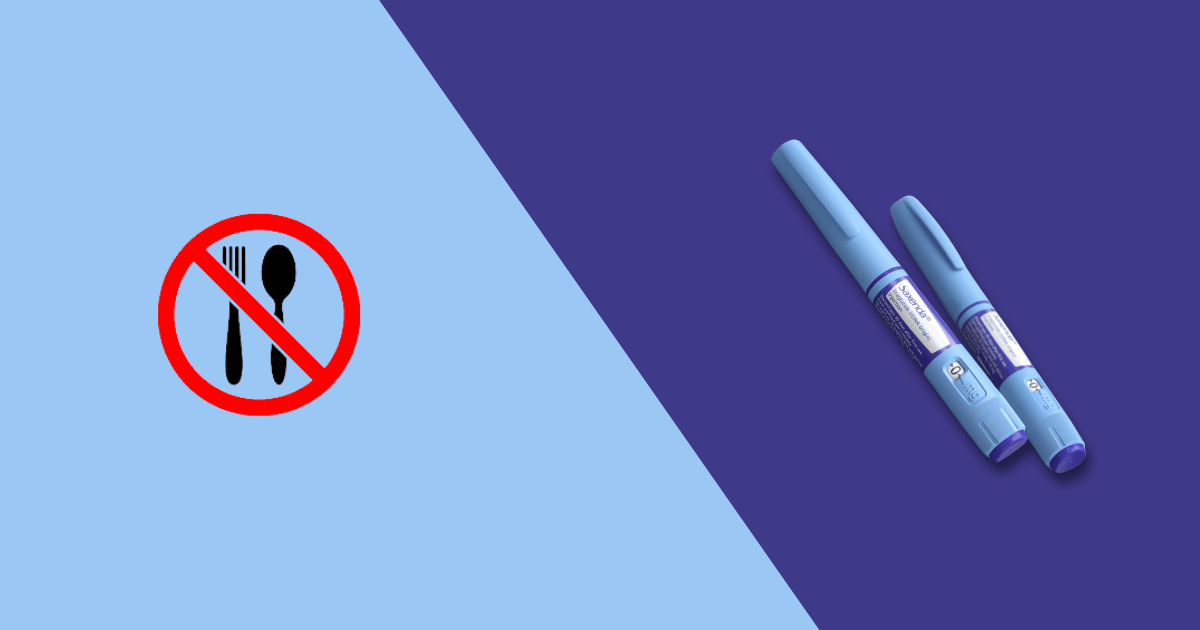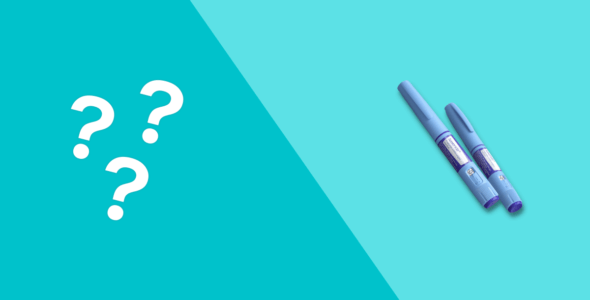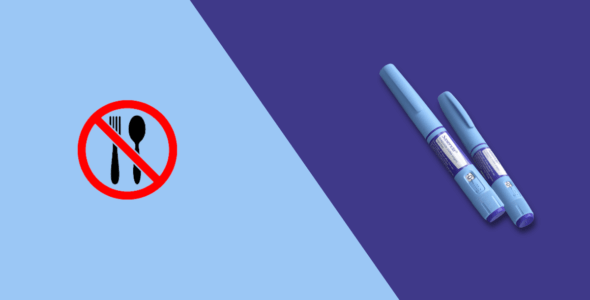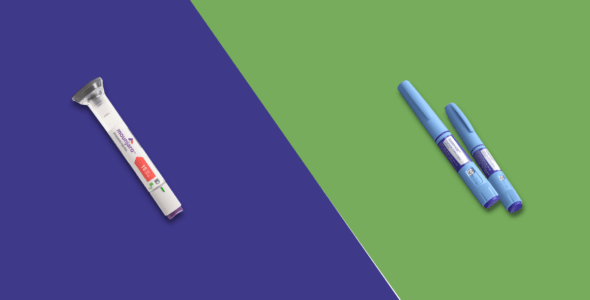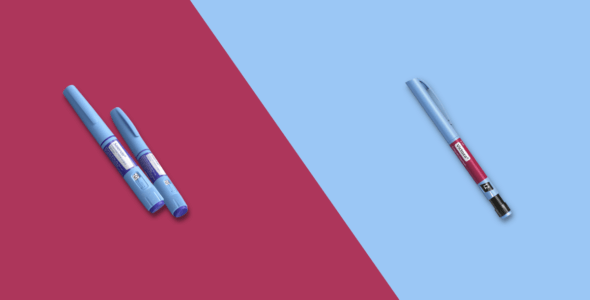Foods to avoid while on Saxenda: A complete guide for better results
Saxenda helps curb cravings and boost weight loss, but only if you steer clear of these foods. Certain food fried can trigger unpleasant side effects and stall your progress. Don’t let your diet work against you. Here’s what to cut out now.
Key highlights
- Saxenda (liraglutide) is an FDA-approved subcutaneous injection used for chronic weight management in adults with obesity or overweight and related health conditions.
- Saxenda works best when combined with lifestyle changes such as a reduced-calorie diet and regular physical activity.
- While taking Saxenda, try to avoid or eat less unhealthy foods like fatty meats, fried foods, fast food, processed snacks like cakes, cookies, deli meats, and sugary foods and drinks.
- While taking Saxenda, it's best to eat low-fat foods, healthy fats, lean proteins, whole grains, and fresh fruits and vegetables. These foods can help you lose extra weight and keep your body healthy.
Saxenda is a GLP-1 receptor agonist made by Novo Nordisk, approved for chronic weight management in adults and adolescents with obesity or weight-related conditions.
Saxenda is a multi-dose pen, taken once a day and injected under the skin (subcutaneously). You can inject the medication under the skin of your stomach (at least 2 inches away from the belly button), upper arm, or thigh.
What you eat can affect how well Saxenda works and how you feel while taking it. Some foods, like greasy, sugary, or heavy foods, can make side effects like nausea, bloating, or heartburn worse.
Eating unhealthy foods can also slow down your weight loss progress. A healthy, balanced diet helps the medication work better and supports your long-term weight loss goals.
Foods to avoid on Saxenda: Understand what not to eat, including high-sugar, fatty, and processed items, to support your weight loss treatment and manage potential side effects effectively.
Why some foods don’t mix well with Saxenda
You can mostly eat normally while taking Saxenda, as there are no strict food rules or restricted foods. However, for achieving the best weight loss results, Saxenda works best when you eat healthy foods.
This means you should follow a calorie-controlled diet and try to eat fewer high-calorie and sugary foods. Eating healthy helps you lose weight with Saxenda and is also good for your overall health in the long run.
When you start taking Saxenda, your healthcare provider will begin with a low dose and slowly increase it over 5 weeks. This helps reduce the chance of feeling sick to your stomach (nausea), which is the most common side effect at the beginning. This nausea usually gets better as your body adjusts to the medicine. Other common stomach problems you might have are diarrhea, constipation, or vomiting.
Unhealthy foods can cause worsening nausea and bloating (common side effects), blood sugar spikes or crashes, and reduced medication effectiveness.
Understanding Saxenda and its mechanism of action
Saxenda is a glucagon-like peptide-1 (GLP-1) medication with the same active ingredient as Victoza (approved for type 2 diabetes), liraglutide. It’s used for chronic weight management in combination with a low-calorie diet and increased physical activity in adults with obesity or overweight.
Saxenda is a daily injection approved for weight loss. Approved in 2014, Saxenda (liraglutide) was the first GLP-1 medication approved for weight loss in adults with obesity or overweight with at least one weight-related health condition, such as high blood pressure or high cholesterol. It is also approved for certain children 12 and older with obesity.
Saxenda (liraglutide) belongs to a class of medications called GLP-1 receptor agonists. It mimics the action of a natural hormone in your body called GLP-1. These medicines are called GLP-1 receptor agonists. GLP-1 is found in the brain and helps control your appetite and how much you eat. Saxenda helps you lose weight by reducing your hunger, increasing feelings of fullness, and reducing your calorie intake. It works best when you also eat healthy and exercise regularly.
Liraglutide, the active ingredient in Saxenda, is also used to lower blood sugar in people with type 2 diabetes. If you have diabetes, your doctor might prescribe a medicine that has liraglutide and helps control blood sugar (brand name Victoza).
In a 56-week clinical trial, people taking Saxenda 3 mg once a day lost an average of 18 lbs, while those using a placebo injection only lost 8 lbs. It has also shown heart health benefits for people with diabetes or those at high risk of heart disease.
Another example of weight loss medication is semaglutide (a GLP-1 receptor agonist), which comes as Ozempic and Wegovy. Victoza is a lower-dose version of liraglutide, the same medicine as Saxenda, and it’s approved to treat type 2 diabetes.
Who is Saxenda for? Eligibility criteria
Saxenda is FDA-approved for chronic weight management in adults with:
-
A Body Mass Index (BMI) of 30 or higher (obesity)
-
A BMI of 27 or higher (overweight) who also have at least one weight-related health condition, such as high blood pressure, Type 2 diabetes, or high cholesterol
Saxenda is also FDA-approved for use in adolescents (12-17 years old):
-
Those who weigh over 132 pounds and are considered obese based on adult BMI
-
Obese, or overweight, with at least one weight-related condition such as high blood pressure, type 2 diabetes, or high cholesterol
Saxenda must be used in conjunction with a reduced-calorie diet and increased physical activity.
Top foods to avoid on Saxenda
When taking Saxenda, you should try to avoid or eat less of some specific foods. These include foods high in saturated fat, greasy or fried foods, fast food, highly processed items like cakes, cookies, and deli meats, and sugary snacks and drinks.
The foods to avoid on Saxenda are the same ones that are unhealthy in general. You don’t need a special meal plan, but it’s important to eat healthy and make better food choices.
1. Fried, greasy, and high-fat foods
Fatty foods are often high in calories and saturated fats, which can slow digestion and potentially worsen gastrointestinal side effects commonly associated with Saxenda, such as nausea, bloating, and constipation. High saturated fat intake can also negatively impact cholesterol levels and heart health. These foods may include:
-
Fried chicken
-
French fries
-
Pizza
-
Bacon
-
Sausages
-
Fatty cuts of meat
-
Full-fat dairy products
-
Heavy cream
-
Butter
-
Lard
-
Heavy cream sauces
-
Fast food (burgers)
-
Greasy snacks
Choose lean protein sources (chicken breast, fish, tofu, legumes), prepare foods using healthier cooking methods like baking, grilling, or steaming, and incorporate healthy fats in moderation (avocados, nuts, seeds, olive oil).
2. High-sugar foods and beverages
These can cause rapid blood sugar spikes, counteracting Saxenda’s benefits on blood sugar control. Excess sugar also contributes to weight gain and can worsen diarrhea.
Examples include:
-
Candy
-
Pastries
-
Cakes
-
Cookies
-
Sugary cereals
-
Soda
-
Fruit juices with added sugar
-
Sweetened coffee drinks
-
Energy drinks
Choose naturally sweet fruits in moderation, unsweetened drinks like water or herbal tea, and whole grain options instead of refined sugar products.
3. Processed foods
These are often high in unhealthy fats, added sugars, and salt, which contribute to weight gain, poor blood sugar control, and digestive issues. They are also low in essential nutrients.
Highly processed foods have more sugar, fat, and salt but fewer vitamins and minerals. Studies show that eating too much of these foods can lead to weight gain.
Some examples of highly processed foods to avoid include:
-
Packaged snacks (chips, donuts, and crackers)
-
Processed meats (deli meats, sausages)
-
Frozen meals
-
Instant noodles
-
Sugary packaged cereals
-
Many sauces and dressings
Focus on whole, unprocessed foods like fresh fruits and vegetables, whole grains, and lean proteins. Cook at home whenever possible to control ingredients.
3. Excessive alcohol consumption
While taking Saxenda, it’s best to avoid or limit alcohol as much as you can. Alcohol adds extra calories to your diet and can make it harder to stick to a healthy diet and exercise plan.
It can also make some side effects of Saxenda worse, like low blood sugar, headaches, and feeling dizzy.
Alcohol can lower blood sugar levels, and when combined with Saxenda, which also has this effect, it can increase the risk of hypoglycemia (low blood sugar). Additionally, alcohol may increase the risk of pancreatitis, a potential side effect of Saxenda.
Limit or avoid alcohol consumption while on Saxenda. If you choose to drink, do so in moderation and be aware of potential interactions and side effects. Consult your healthcare provider for personalized advice.
4. Foods high in sodium
High sodium intake can lead to water retention, bloating, and increased blood pressure, potentially counteracting some of the health benefits of weight loss. Processed foods are often significant sources of hidden sodium.
Examples include:
-
Fast food
-
Deli meats
-
Processed snacks (chips, pretzels)
-
Canned soups
-
Pickled foods
-
Many sauces and dressings
Choose fresh, whole foods, use herbs and spices for flavoring instead of excessive salt, and read food labels to monitor sodium content.
5. Artificial sweeteners and sugar alcohols
Some people experience bloating and gas from artificial sweeteners and sugar alcohols. New research also shows a negative impact on gut bacteria in some cases.
Examples include:
-
Sucralose
-
Aspartame
-
Saccharin
-
Erythritol
-
Sorbitol is found in diet sodas
-
Sugar-free candies
-
Some processed foods
Pay attention to how your body reacts to these ingredients and consider stevia in moderation or reducing overall sweetness in your diet.
6. Spicy and acidic foods
Spicy and acidic foods can irritate the lining of your stomach. When you’re on Saxenda, your stomach may already be more sensitive due to common side effects like nausea, heartburn, or indigestion.
Eating these types of foods will make those symptoms worse and more uncomfortable, or even make it harder to stick to the medication.
Examples include:
-
Hot peppers
-
Citrus juices
-
Tomato-based sauces
-
Vinegar-based dishes
Limit these foods, especially when you first start Saxenda or if they bother you.
7. Large portions and heavy meals
Large portions and heavy meals can cause discomfort while on Saxenda because the medication slows down digestion. When you overeat, food stays in your stomach longer, which can lead to bloating, nausea, or a feeling of being too full.
When you eat a big meal, your stomach has to work harder to digest all the food, and with Saxenda in your system, that process takes even longer. As a result, you may feel overly full or sluggish for hours after eating, which can make it harder to stay consistent with the medication and your healthy eating plan.
Instead of eating large meals, try having smaller, well-balanced meals more often throughout the day. This helps your stomach handle food more comfortably, supports steady energy levels, and helps keep your appetite under control.
8. Foods high in saturated fat
Fat has more calories than protein or carbs. Reducing food intake with less saturated fat can help you lose more weight.
Here are some foods high in saturated fat:
-
Lard
-
Butter
-
Heavy cream
-
Sausages and bacon
-
Red meat
-
Dark chicken meat
-
Cheese
-
Coconut and coconut oil
-
Palm oil
Eating too much saturated fat can increase the risk of health problems like heart disease. Studies show that eating less saturated fat may lower the risk of heart attacks or strokes.
It’s essential to remember that any changes to your weight loss medication, whether starting, stopping, or switching, depend on your medical condition and should only be made under the medical advice of a qualified healthcare provider. Always tell your doctor or pharmacist about all over-the-counter medications, supplements, and vitamins you take.
Foods to eat while on Saxenda
To lose weight, manage side effects, and improve overall health on Saxenda, focus on incorporating these food groups into your daily diet:
1. Lean proteins
Eating lean proteins will make you feel full and satisfied, help with muscle mass during weight loss, and stabilize blood sugar.
Certain examples include:
-
Chicken breast
-
Turkey
-
Fish (salmon, tuna, cod)
-
Tofu
-
Tempeh
-
Beans
-
Lentils
-
Eggs
-
Greek yogurt
2. Non-starchy vegetables
Non-starchy vegetables are low in calories and high in fibre, vitamins, and minerals. They will keep you full and provide essential nutrients. Try to fill half your plate with these foods.
Examples include:
-
Leafy greens (spinach, kale, lettuce)
-
Broccoli
-
Cauliflower
-
Bell peppers
-
Cucumbers
-
Zucchini
-
Asparagus
-
Brussels sprouts
3. Fiber-rich whole grains
Whole grains make you full, help with digestion, and give you sustained energy. Choose whole grains over refined grains whenever you can.
Examples include:
-
Quinoa
-
Brown rice
-
Whole-wheat bread and pasta
-
Oats
-
Barley
4. Fruits (in moderation)
It has vitamins, minerals, and fiber. Choose whole fruits over fruit juices because of the higher fiber content. Be mindful of portion sizes because of the natural sugar.
Examples include:
-
Berries
-
Apples
-
Pears
-
Citrus fruits
5. Healthy fats (in moderation)
Healthy fats are important for overall health, can make you full, and help with the absorption of some nutrients. Be mindful of calorie density and consume in moderation.
Examples include:
-
Avocados
-
Nuts
-
Seeds
-
Olive oil
Tips to minimize side effects and maximize results
-
Eat slowly to avoid nausea: Eating slowly helps you notice when you’re full, so you can stop eating at the right time. This means you’ll eat fewer calories per meal. Pay attention to your hunger and fullness cues. It takes about 20 minutes for your brain to register fullness.
-
Eat smaller, more frequent meals: This helps with appetite and prevents overeating, especially since Saxenda affects digestion.
-
Avoid lying down after meals: To reduce side effects and get the best results, don’t lie down right after eating. This helps prevent acid reflux and keeps your stomach comfortable.
-
Stay hydrated: Drink plenty of water throughout the day. It helps you feel full, and less hungry, and drink fewer high-calorie drinks, which is good for overall health and can prevent constipation.
-
Prioritize protein at each meal: Make sure to include protein in every meal. This helps you feel full longer and keeps your blood sugar stable.
-
Learn to read food labels: Pay attention to calorie content, serving sizes, sugar, fat, and sodium levels to make healthier choices.
-
Avoid overly restrictive diets: Don’t follow diets that are too strict. Healthy weight loss comes from balanced eating, not from cutting out too much.
-
Don’t skip meals: This can lead to increased hunger and potential overeating later.
-
Combine with regular exercise: Along with healthy eating, try to do at least 30 minutes of moderate to hard exercise at least 5 days a week. It’s also good to do strength exercises like weight lifting to keep your metabolism working well. Exercise complements Saxenda and is important for long-term weight management and overall health.
-
Get adequate sleep: Sleep plays a big role in hormone regulation, including those that control appetite. Aim for 7-9 hours of quality sleep per night.
-
Manage stress: Stress can lead to unhealthy eating habits. Find healthy ways to manage stress, like exercise, meditation, or spending time in nature.
-
Listen to your body: Pay attention to how different foods make you feel and adjust your diet accordingly.
-
Consult Your healthcare provider or a registered dietitian: They can give you personalized advice based on your individual needs and health status.
Potential side effects
The most common side effects of Saxenda are usually mild and tend to improve over time:
-
Nausea
-
Vomiting
-
Diarrhea
-
Constipation
-
Headache
-
Stomach pain
-
Dizziness
-
Fatigue
-
Hoarseness
-
Hypoglycemia or low blood sugar (especially when used with diabetes medications)
-
Decreased appetite
-
Trouble swallowing
Rare and serious side effects of Saxenda that may require immediate medical attention include:
-
Pancreatitis (inflammation of the pancreas)
-
Gallbladder problems (gallstones)
-
Kidney problems (including kidney failure)
-
Increased heart rate or fast heartbeat
-
Injection site reactions
-
Suicidal thoughts
-
Serious allergic reactions
FAQs about Saxenda and diet
Can I ever eat these foods?
Yes, you can have these foods once in a while. It’s important to eat them only in small amounts and not too often.
Does Saxenda cause food aversions?
Some users taking Saxenda report changes in taste and food aversions, which means you might not like some foods as much as before.
How long before Saxenda suppresses appetite?
Saxenda usually starts to suppress your appetite within 1 to 2 weeks. It may take some time for you to notice the full effect. On average, patients may lose 5% to 10% of their body weight over several months with proper diet and exercise.
How can I prevent nausea and stomach upset with Saxenda?
To help prevent nausea and stomach upset, start with a low dose of Saxenda and increase it slowly as your doctor says. Eating smaller meals and avoiding greasy or spicy foods can also help.
Conclusion
It’s important to know that Saxenda works best with a healthy lifestyle, such as eating fewer calories and exercising more.
While there is no specific diet plan, avoiding unhealthy foods while taking Saxenda can lead to better comfort, fewer side effects, and improved weight loss results.
By steering clear of greasy, sugary, and highly processed foods and choosing healthier options instead, you’ll help the medication work more effectively and feel better day to day.
Remember, even small changes in your eating habits can make a big difference over time. Focus on balance, listen to your body, and take it one step at a time.
For the best results, consult your healthcare provider or a registered nutritionist. They can help create a personalized plan that fits your health needs and goals.
